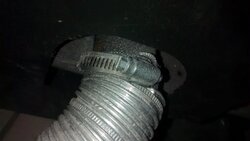Preparing to install an oak on my Cumberland (avatar pic).
Planning to run 3" metal duct vent pipe from back of stove along brick hearth then 90 out rear wall. At that point it will 90 again inside an attached garage then vent out to the outside through the garage wall.
I'm using the 3" rigid vent due to length of the draw and the 3 90s in the run. Plus I can paint it black, helping to hid the pipe leaving the hearth pad.
Problem: I can't locate a 3" to 2" reducer to connect air intake on stove to 3" metal duct work. (shouldn't be this hard)
Simpson makes a reducer (3pvp-inc) however I can't locate a supplier. I've searched the net for any other metal reducer and apparently no one makes one.
Any suggestions?
I see from other postings that many people are using pvc, however local code requires metal duct.
Planning to run 3" metal duct vent pipe from back of stove along brick hearth then 90 out rear wall. At that point it will 90 again inside an attached garage then vent out to the outside through the garage wall.
I'm using the 3" rigid vent due to length of the draw and the 3 90s in the run. Plus I can paint it black, helping to hid the pipe leaving the hearth pad.
Problem: I can't locate a 3" to 2" reducer to connect air intake on stove to 3" metal duct work. (shouldn't be this hard)
Simpson makes a reducer (3pvp-inc) however I can't locate a supplier. I've searched the net for any other metal reducer and apparently no one makes one.
Any suggestions?
I see from other postings that many people are using pvc, however local code requires metal duct.



